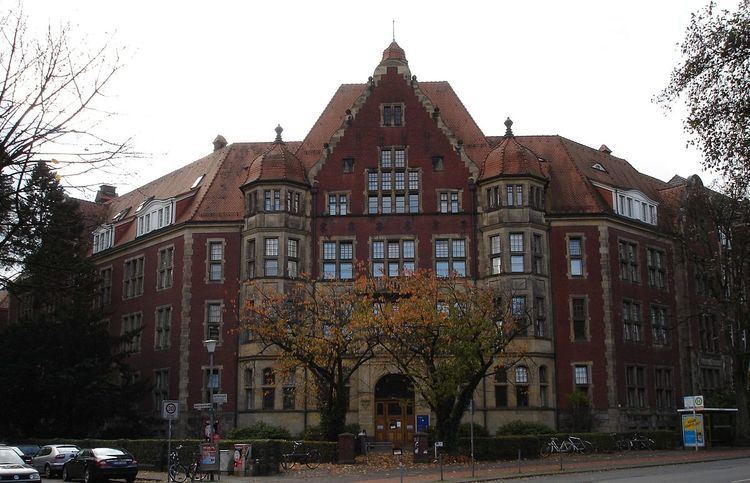Type Public University President Ute von Lojewski Website www.fh-muenster.de Phone +49 251 830 | Established 1971 Number of students 13,974 Total enrollment 13,329 (Feb 2015) Founded 1 August 1971 | |
 | ||
Address Corrensstraße 25, 48149 Münster, Germany Number of employees 260 (1,000, of which professors) Similar Fachhochschule Münster - Steinfurt, University of Münster, Fachhochschule Münster, Hochschule Niederrhein - University, University of Wuppertal | ||
Fachhochschule Münster (Münster University of Applied Sciences), based in the Westphalian city of Münster with a second campus in Steinfurt, has a student enrolment of around 13,974 (as of winter semester 2015/16), making it one of the largest public universities of applied sciences in Germany. It has twelve faculties and two central scientific units.
Contents
- Historyfoundation
- Faculties and central scientific units
- Degree programmes
- Research
- Key research activities
- Institutes
- International cooperative agreements and contacts
- Mnster
- Steinfurt
- References
The University offers around 87 degree programmes (as of winter semester 2015/16) in the fields of business and management, engineering, design, health, social studies and teacher training. In November 2011, Münster University of Applied Sciences was the first university of applied sciences in Germany to successfully complete the process of system accreditation: since then, the University has been able to accredit its degree programmes itself – without the need for assessment by external agencies.
History/foundation
Münster University of Applied Sciences was founded in 1971. It was established as a result of an amalgamation of state and private construction and engineering colleges.
Faculties and central scientific units
Münster University of Applied Sciences is divided into twelve faculties, seven of which are in Münster, the other five in Steinfurt. The largest faculties are the Faculty of Business Administration and the Faculty of Social Studies.
There are also two central interdisciplinary institutes where students can train to become vocational school teachers or industrial engineers.
Degree programmes
The 70 or more Bachelor and Master’s programmes on offer are spread across the areas of business and management, engineering, design, health, social studies and teacher training. Dual and executive degree programmes are also offered at the University, as well as international degree programmes.
Münster was one of the first universities of applied sciences to establish a doctoral programme. Outstanding students have to option to realise their PhD project in cooperation with universities at home or abroad.
Münster University of Applied Sciences fully met the requirements of the Bologna Process, namely of creating harmonised academic qualifications across Europe, and completely converted its study programme to the tiered Bachelor/Master’s system by winter semester 2007/2008.
Research
In recent years, Münster University of Applied Sciences has been one of the universities of applied sciences with the most third-party funding in Germany. The numerous research endeavours are increasingly being flanked by collaborative PhDs.
Key research activities
Institutes
International cooperative agreements and contacts
Münster University of Applied Sciences currently has around 195 active international university contacts (as of summer semester 2014), some 120 of which are via the European exchange programme ERASMUS.
Münster University of Applied Sciences is a member of the higher education consortium UAS7, an alliance of seven research-oriented universities of applied sciences with an international outlook. The shared objective is to foster cooperation with higher education institutions in North and South America.
Münster
The following facilities are located in Münster: the faculties of Architecture, Civil Engineering, Design, Home Economics and Nutritional Sciences – Facility Management, Nursing and Health, Social Studies, Business Administration and the Institute of Teacher Training for Vocational Education (IBL).
The Westphalian city of Münster has a population of nearly 300,000. Around 50,000 people study at one of the city’s eight higher education institutions. The city has a lot to offer in the way of leisure and culture, as well as a local recreation area around the Aasee.
Münster was the first city of its size to be awarded the title of the World’s Most Liveable City.
Steinfurt
Steinfurt is home to the faculties of Chemical Engineering, Electrical Engineering and Computer Science, Mechanical Engineering, Energy • Buildings • Environment, Engineering Physics and the Institute of Business Management in Technology (ITB). Over 3,000 students are enrolled on degree programmes at the faculties in Steinfurt.
The district town has a population of around 35,000, and is a business location with many medium-sized enterprises. Trains operate between Steinfurt and Münster every hour.
